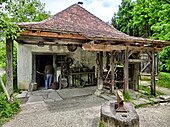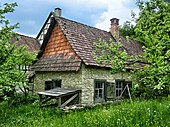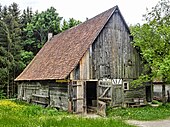Open-air museum Neuhausen ob Eck

|
|
| Data | |
|---|---|
| place | Neuhausen ob Eck |
| Art | |
| opening | 1988 |
| Number of visitors (annually) | 90,000 |
| operator | |
| management |
Almut Grüner
|
| Website | |
| ISIL | DE-MUS-323615 |
The Neuhausen ob Eck open-air museum northeast of Neuhausen ob Eck in the Tuttlingen district is one of seven regional rural open-air museums in Baden-Württemberg . It covers an area of 18 hectares in the Obere Donau Nature Park .
Tourist importance
The museum village, which opened in June 1988, is visited by an average of around 90,000 guests every year in the seven-month season from April to October. In the 2011 season, for the first time in 20 years, more than 100,000 visitors came, of which more than 11,000 pupils got to know the museum village through the “School in the Museum” project.
Since May 2008 the open-air museum has also been one of 26 information points of the UNESCO Geopark Swabian Alb .
building
The meanwhile 25 historical buildings come from the regions of Swabian Alb , Black Forest , Hegau , Baar , Upper Neckar and Lake Constance .
The museum village includes, among other things, the Hölzle bakery, the Obernheim sheepfold, the waterwheel-operated high-rise saw from the Behlishof near Unterkirnach, the St. Georgen washing and baking house, Sommerau, the Pfeiffer department store from Stetten am kalten Markt , the Mennwangen small farm and a rope factory from Rottenburg. The carefully selected buildings, often threatened with final demolition at their original location, were carefully removed and rebuilt in the museum.
The establishment was also carried out as faithfully as possible after questioning previous residents or with the help of written documents. Likewise, the gardens and courtyard areas were designed according to the social and economic status of the former owners.
The following markings A 1 to E 1 correspond to the information on the buildings in the various areas specified in the museum plan.
Courtyard
Gasthaus Ochsen (A 1)
Built: 1707; Renovated: 1864 Time of
presentation: 19./20. Century.
Original location: Schopfloch in the Freudenstadt district.
Among other things, the finely crafted half-timbering on the gable end testifies to the wealth of its former owners . The former Schildwirtschaft on the road from Tübingen to Strasbourg was in operation until 1951 .
The house serves as the entrance building of the museum, on the first floor there is an inn.
Barn Haberstenweiler (A 2)
Built: 1796 Time of
display: 19th century
Original location: Stiefelhof in Salem - Haberstenweiler in the Lake Constance district
Schömberg farmhouse , so-called Bärbele-Haus (A3)
Built: after 1750
Display time: Ground floor around 1870, upper floor around 1920
Original location: Schömberg in the Zollernalb district
Backhaus Hölzle (A4)
Built: 19th century
Display time: 19th/20. Century
Original location: Bietingen , Sauldorf in the district of Sigmaringen
Sheepfold Obernheim (A5)
Built: 1881/82
Original location: Obernheim in the Zollernalb district
Black Forest assembly group
House / grain mill (B 1)
Built: 1767
Display time: 19./20. Century
Original location: the Harzerloch near Peterzell in St. Georgen in the Black Forest in the Schwarzwald-Baar district.
The grain mill , driven by a water wheel, is a purely wooden structure: the stand frame up to the parapet height with strong wooden planks, above it with vertical boards between the posts. The open interior offers enough head height for the grinder to be poured. It was the house mill of the Hochbronner Hof and freed the forest farmers from the ban on the landlord's mill.
Hausmühle Peterzell (B2)
Built: late 18th century
Time of presentation: 19th / 20th century. Century
Original location: Behlishof in Unterkirnach in the Black Forest-Baar district
Oberkirnach storage facility (B 3)
Built: unknown
Display time: 19./20. Century
Original location: Stoffelhof in Oberkirnach in St. Georgen in the Black Forest in the Schwarzwald-Baar district
Haldenhof (B 4)
Built: 1669
Display time: 19./20. Century
Original location: Schonach in the Black Forest , Schwarzwald-Baar district
Baking and washing house (B5)
Built: around 1800 Time of
presentation: 19th century
Original location: Vorderer Christhof in Sommerau near St. Georgen in the Schwarzwald-Baar district
Albdorf
Village square
with former city fountain from Tuttlingen (1873)
Day laborer's house (C 1)
Built: late 18th century
. Time of
presentation: mid 19th century.
Original location: Delkhofen , municipality of Deilingen in the Tuttlingen district
Weaver's and smallholder house (C 2)
Built: 1683 Time of
display: mid 19th century
Original location: Dautmergen in the Zollernalb district
School and Town Hall (C 3)
Built: 1830
Display time: 19./20. Century
Original location: Bubsheim in the Tuttlingen district
Forge (C 4)
Built: around 1690 Time of
display: beginning of the 20th century
Original location: Durchhausen , Tuttlingen district
The forge , which was in operation until 1967, has two extensions and an “emergency” - here horses were attached to horseshoes and cows and oxen were clawed .
Hüle cattle
trough and extinguishing water pond on the arid Swabian Alb
Hafnerwerkstatt (C 5)
Built: 1826 Time of
display: 19th century
Original location: Neuhausen ob Eck
Farmhouse Biehle (C 6)
Built: 18th century
Time of presentation: around 1925
Original location: Neuhausen ob Eck
The Biehle was a feudal yard of the All Saints Monastery in Schaffhausen , which had large estates in Neuhausen. A shoemaker's workshop is set up on the ground floor, and the upper floor is used for special exhibitions. Until 2018 the exhibition “ Between the Fronts ” explains rural life in times of war.
Village church (C 7)
Built: 15th century; Enlargement: second half of the 18th century
. Time of
illustration: 19th century.
Original location: Tischardt , municipality of Frickenhausen in the district of Esslingen.
The small, Protestant church with late Gothic door garments and window frames had to give way to the expansion of the Tischardt through-town. Among other things, it is equipped with a gallery, an altar , a baptismal font and a harmonium that extend into the choir .
Sheep and Farrenstall (C 8)
Built: around 1812; Dismantling: 1989; Reconstruction: 1990/1991 Time of
presentation: 19./20. Century
Original location: Brittheim , City of Rosenfeld in the Zollernalb district
Apiary (C 9)
Built: 1933
Time of display: 20th century
Original location: Aixheim , municipality of Aldingen in the district of Tuttlingen
“Pfeiffer” department store (C10)
Built: 1852 Time of
display: 20th century
Original location: Stetten am kalten Markt in the district of Sigmaringen
The department store (1925 to 1995) shows a wide range of goods; today the museum shop offers the opportunity to purchase regional products.
Upper Neckargäu / Alb foreland assembly group
Farmhouse Mariazell (E 1)
Built: around 1606
Display time: 19./20. Century
Original location: Mariazell , municipality of Eschbronn in the Rottweil district
Others
Mennwangen small farmhouse (D1)
Built: probably in the 17th century
. Time of
presentation: 19th century.
Original location: Mennwangen , Deggenhausertal municipality in the Lake Constance district
Rope factory Rottenburg am Neckar (D2)
Built: 1935 Time of
display: 20th century
Original location: Rottenburg am Neckar in the Tübingen district
Schramberg storage shed
Built: 1923 Time of
display: 20th century
Original location: Schramberg in the Rottweil district.
The shed, which is not accessible to visitors, serves the museum as a depot and workshop
Museum offers
The museum offers an extensive program of events with many educational museum offers, special days of action and changing special exhibitions. There are tradesmen and technology demonstrations every day. The highlights are the Carter's Day with demonstrations with draft horses , the nationwide Mill Day , at which the museum shows its high-rise saw from 1780 and its small grain mill from 1767, the Baden-Württemberg Folk Music Day with traditional Swabian-Alemannic folk music by numerous folk music groups and the Kirbe Museum Festival .
A special project is the "historic pig's hat". Every afternoon from May to October a free-range pig herd is led through the museum village by the swineherd.
For school classes, the museum offers numerous themed and action-oriented projects as part of the museum's educational program “School in the Museum”. Up to ten school classes explore the museum village every day. Well over 10,000 students and over 600 school classes use this offer in one season. The projects include spinning and weaving, flax processing, cooking in the old museum kitchen, forging in the village smithy, clay painting in half-timbered construction, plowing, threshing or baking in the bakery with flour from the mill.
Horse- powered hay tedder
animals and plants
The museum keeps pets , cattle , donkeys , pigs , sheep , goats , chickens , geese and barn rabbits during the museum season . Most of them are descendants of old domestic animal breeds such as Merinoland sheep , Vorderwälder cattle , Swabian-Hällische country pigs or colorful German noble goats .
Old crops such as flax , old grains and potatoes are grown in the fields .
Film set
2007 was the Farrenstall film set for the film Krabat .
In February 2011, the shooting of Die Sterntaler , a film adaptation of this Grimm fairy tale for the ARD fairy tale series “ Six in one stroke ”, took place.
From August 8 to 15, 2011, the “Haldenhof” from Schonach was the backdrop for the Australian-English-German cinema production Lore .
Others
In the center of the area, a typical cave for the Swabian Alb was reproduced.
A Hanomag Garant (built in 1938) and a Mercedes 170 VA (built in 1951) were found on the cold market while moving the former Pfeiffer department store in Stetten and donated to the open-air museum in April 2010 by a grandson of Pfeiffer.
See also
literature
- Herbert Jüttemann: saw and mill. The technical cultural monuments of the newly built open-air museum Neuhausen ob Eck. In: Preservation of monuments in Baden-Württemberg , Volume 18, 1988, Issue 2, pp. 110–113. ( PDF; 11.5 MB )
Individual evidence
- ↑ Open-air museum breaks visitor record. For the first time in 20 years more than 100,000 guests - nice farewell present for District Administrator Wolf. In: Schwäbische Zeitung from November 9, 2011
- ↑ A1 Gasthaus Ochsen ( Memento of the original from April 28, 2015 in the Internet Archive ) Info: The archive link was inserted automatically and has not yet been checked. Please check the original and archive link according to the instructions and then remove this notice. on the website of the open-air museum Neuhausen ob Eck; accessed on May 10, 2015
- ↑ B1 Hausmühle from Hochbronner Hof Peterszell ( Memento of the original from May 11, 2015 in the Internet Archive ) Info: The archive link was inserted automatically and has not yet been checked. Please check the original and archive link according to the instructions and then remove this notice. on the website of the open-air museum Neuhausen ob Eck; accessed on May 10, 2015
- ↑ C4 Dorfschmiede Durchhausen ( Memento from October 8, 2007 in the Internet Archive ) on the website of the Neuhausen ob Eck open-air museum; accessed on May 23, 2015
- ↑ Thin people make you want to learn . In: Südkurier of July 30, 2010
- ↑ Falko Hahn (fah): Casting for a fairy tale film in the sheepfold . In: Südkurier from January 31, 2011
- ↑ Open-air museum as a film set . In: Südkurier of August 4, 2011
Web links
Coordinates: 47 ° 58 '48.2 " N , 8 ° 55' 43.4" E





















